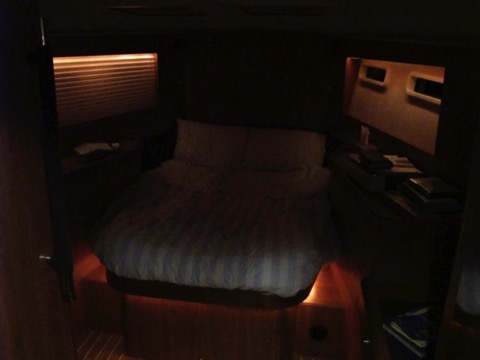LED Lighting in the real world
18/03/10 03:49 Filed in: Electrical
We took the new boat out to anchor for the first time a couple of nights ago. It is great to have the time to be testing systems and sorting things out without being in a big hurry. It is just early spring here and we were the only people in a normally popular anchorage in Chichester Harbour.
Also a chance to do some real world testing with the Imtra LED lighting. WOW. We already new the lights looked great from seeing them on at the boat show in January. But now I have been able to see just how little power they use. I did tests on most of the lights at anchor. I have a few interesting pix below. Of course it is difficult to get a representative feel with the camera but I did my best. The camera must be set to all manual operation so it doesn’t adjust for dimmer lighting.

This is the forward cabin lit by 4 big downlights in the ceiling plus the two reading lights at the head of the bed. Together the 6 lights draw just about 2.5 amps. To put that in perspective that would have been just over ONE 25watt halogen. These lights are so efficient we can just turn them on at anchor whenever we want. No worries about power. The saloon was the same story. The 6 big downlights light the saloon and galley with a nice warm bright light for just 2.5 amps. This compares to the 42 (similar space but lit with halogen lights) which used over 10 amps. So we have cut the power needed to run lighting by 75% or so!
Now here’s a real surprise. While I was checking I turned on the cute mood lights Northshore have installed in all sleeping cabins. These are not LEDs, but the rope lighting often used for decorating. This used more than the main lights! In fact the shot below is actually using almost double the shot above in power but producing almost no usable light. But it does look nice...

LED lighting really is here now. You can get very good looking light that will save a lot of power. And remember that saving power means you don’t need to generate and store it as well. So saving the power as we sat at anchor meant we didn’t have to replace that power the next morning. If you are planning an electrical budget you can stay with slightly smaller batteries.
Also a chance to do some real world testing with the Imtra LED lighting. WOW. We already new the lights looked great from seeing them on at the boat show in January. But now I have been able to see just how little power they use. I did tests on most of the lights at anchor. I have a few interesting pix below. Of course it is difficult to get a representative feel with the camera but I did my best. The camera must be set to all manual operation so it doesn’t adjust for dimmer lighting.

This is the forward cabin lit by 4 big downlights in the ceiling plus the two reading lights at the head of the bed. Together the 6 lights draw just about 2.5 amps. To put that in perspective that would have been just over ONE 25watt halogen. These lights are so efficient we can just turn them on at anchor whenever we want. No worries about power. The saloon was the same story. The 6 big downlights light the saloon and galley with a nice warm bright light for just 2.5 amps. This compares to the 42 (similar space but lit with halogen lights) which used over 10 amps. So we have cut the power needed to run lighting by 75% or so!
Now here’s a real surprise. While I was checking I turned on the cute mood lights Northshore have installed in all sleeping cabins. These are not LEDs, but the rope lighting often used for decorating. This used more than the main lights! In fact the shot below is actually using almost double the shot above in power but producing almost no usable light. But it does look nice...

LED lighting really is here now. You can get very good looking light that will save a lot of power. And remember that saving power means you don’t need to generate and store it as well. So saving the power as we sat at anchor meant we didn’t have to replace that power the next morning. If you are planning an electrical budget you can stay with slightly smaller batteries.
blog comments powered by Disqus